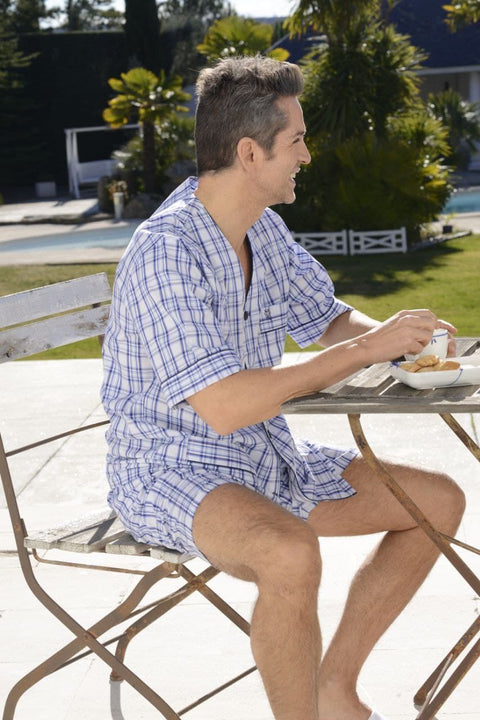When it comes to changing the bed linen or buying a good pajama, it seems like quite a task that for some gentlemen might even be a useless job, since the truth is that more and more men are getting involved with their image even at bedtime.
Aspects such as fabrics, cut, and the style of the piece that previously went unnoticed now gain special interest as parameters for choosing a pajama. One of these factors worth occasionally analyzing is related to color psychology, because the colors used in outfits actually affect emotions much more than is commonly thought.
Many scientific publications have devoted their time to researching and developing certain postulates that clearly explain the language of color in garments.
The Favorite Color
Obviously, there are very specific tastes and it certainly has nothing to do with gender; for example, pink can often be seen in quite elegant men's garments. Black is usually the preferred color among the male audience, and one can wear black from head to toe almost daily, but a pajama of that color can well cause some unease, although among women it is very common exclusively in lingerie for sleeping.
It is that "in general, it is not common to realize the psychological impact of color in daily life, because it is associated with something superficial or purely aesthetic. And it is really important because it can help in a very gentle way to better self-knowledge, express aspects of personality, and feel physically and emotionally more fulfilled," a direct quote from Domingo Delgado, a psychologist expert in image coaching and color psychology.
A Matter of Taste
Although essentially clothing colors are usually chosen simply based on personal taste, the reality is quite different, as the expert explains in detail. Clothing has a great impact that goes far beyond aesthetics, since "it affects the entire belief system, which involves thinking, feeling, and acting." What Delgado states in this quote is that it involves physical mechanisms where colors as stimuli directly influence the emotional level.
"When wearing a garment, the first thing that happens is that the color causes a physical sensation that activates each person's emotional state. It works somewhat like turning on a light switch (the color). By doing so, it triggers an alert for more attention to the illuminated area (emotions)."
The psychologist also adds that, "each tone influences certain very specific psychological aspects, and, depending also on how these colors are combined with each other, this will directly affect the type of reaction we have. These sensations predispose the individual to very specific attitudes that definitely affect the mental structure or way of thinking of each person."
Emotions and Color
So, as a good guide, the summary made by the expert is indeed quite simple. It confirms that it ultimately depends on the degree of sensitivity one has, which may intuitively influence the choice of certain colors to create a better setting in each situation.
Although it is obvious that everything depends on each person and what they need at each moment, the expert says that "the first thing is to ask oneself what generates insecurity regarding one's image, not to try at all to disguise the answer nor the self-concept of personal image"; Delgado also states that there are certain basic colors that can considerably help at the emotional level and, therefore, influence behavior in some way.
As Guidance
Initially, it is about providing guidance; ultimately, the choice will always be the customer's. According to this guide provided by the expert, warm colors encourage much more open ideas and also being more proactive. Surely, a pajama in these colors will allow you to have a very productive day.
On the other hand, cool colors inspire more concrete and deep thoughts. It is equivalent to having more analytical states of mind, which, in simple terms, can lead to reflections before falling asleep.
Likewise, and in more detail, green brings balance, hope, and calm; earth tones provide more stability. Bright and bold colors such as red throughout the palette help to feel more personal power. Black conveys the idea of setting a boundary between mood and circumstances.
Just as colors affect us emotionally, they also contribute to the construction of messages and, of course, to conveying them. Therefore, although these are not universal and absolute rules, emphasis is placed on the importance of choosing the palette by adapting each color to the specific situation and the message to be sent, whatever the context may be.
In this context, blue tones convey confidence, which surely makes an impact on leadership figures. Bright and cheerful colors convey greater openness. Complementary colors combined with each other convey creativity, which also fosters environments that demand the development of this skill. More basic colors like black and gray signify commitment, which should be combined with other tones intelligently. Of course, the classic white color signifies excellence.
Colors That Help Nighttime Rest
Involving the concrete fact of nighttime rest related to the garments used for sleeping, in the same way that choosing certain colors for the decoration of both the home and the bedroom affects the mood, just as it happens with the colors used in the clothes chosen for sleeping, which involves both the bedding and the pajamas, as it directly influences the emotional realm.
Experts in this area of fashion and functional design in harmony, it is a fact that, in bedding as well as in choosing the most suitable pajamas, combinations of neutral colors in all their ranges are the most recommended options for better sleep, such as soft grays, beige, earth tones, washed blues, grayish greens, among these shades.
Analyzing the context, it is easy to realize that in the end everything makes sense, since observing in detail, it is well justified that sportswear has brighter and fluorescent colors; because going to the gym means getting into action, oxygenating oneself, and taking care of the body through activity and physical exercise.
Therefore, if the activities are more aerobic and strength-based, brighter colors come into play such as red, orange, yellow combined with black, grays, and blues, citrus tones that activate the necessary sense of dynamism.
If the activities are anaerobic and relaxing, for example, like yoga; then the criterion of lighter and softer colors prevails, to promote a more passive state up to a certain knit. The truth is that, ultimately, there are many factors to consider in choosing the perfect pajama.
Access our website El Búho Nocturno where you will surely find it.

